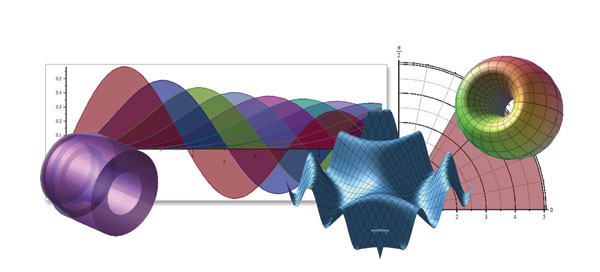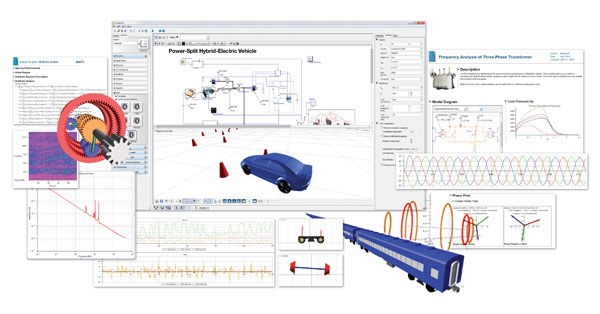Latest News
June 1, 2012
By Peter Varhol
Engineering design can be supported either by formal mathematical analysis or by simulation in some way, such as Monte Carlo. If the forces involved aren’t well understood, or if the math is complex, many turn to simulations—and often to over-engineering—to compensate.
For those whose engineering design efforts involve a fair amount of formal analysis, one of the leading symbolic mathematics engines available is Maple, a mature and capable solution now in its 16th major release (I have a copy of Maple 5 on my bookshelf from circa 1994). Maple helps engineering design efforts through its ability to define designs and forces through symbolic equations, and solve those equations. Maple also provides the ability to easily create graphs from equations that can help in visualizing different aspects of a design.
In this release, Maplesoft continues to work to broaden the base of potential Maple users, with features that shorten the learning curve and make it more accessible to a larger community, as well. These features make Maple more usable in general, and help engineers do more analysis prior to building simulations and prototypes.
The product includes several of these features under the umbrella of “Clickable Math,” a term that brings to mind using the mouse to click your way to a solution. Clickable Math includes the ability to solve equations by dragging individual terms around on the screen, and the ability to use Smart Popups to look at results of individual parts of equations before solving the entire equation. Both approaches open up the realm of symbolic solutions to the simple click of a mouse button, rather than a complex analytical process.
Working Together across the Cloud
MapleSoft 16 continues to encourage collaboration among distributed individuals and teams through the Maple cloud, an online repository and set of communities that exchanges Maple programs, lessons and assistance on analyses, irrespective of industry, geographical location or application. Users can also create ebooks from their Maple documents using the eBook Tools package—making it possible to package applications, graphs, plots, analyses and supporting documentation together into a PDF booklet.

In Maple 16, Smart Popups and Drag-to-Solve join other Clickable Math tools for the
next phase in mathematics software usability.
Collaboration, especially across distributed teams using cloud services, is becoming the new normal of a lot of engineering projects. Maple is taking advantage of collaboration approaches to share information, applications and tools across distributed groups, and to facilitate learning by asking in the cloud.
In addition to being a symbolic mathematics engine, Maple is also a programming language. Engineers can use a combination of symbolic equations and a simple instruction-based language to create mathematics programs that solve equations and inject them into larger-system designs and simulations. Engineers can write programs to analyze data, create plots, and do other solutions or computations if needed on a regular basis.
Many engineers don’t have a large need for the programming aspect of Maple. Analyses primarily consist of single-use equations, although engineers may copy apps and other equations from analysis to analysis if they are required. But some will appreciate the ability to write and reuse programs with the ability to input data from external sources, and apply more complex sequences of solutions to engineering problems.
All about the Math
Of course, Maple continues to excel at symbolic mathematics and computations in general. Even though much of Maple is built using the Maple programming language, it performs very well for most exploratory computations.
The ability to visualize data with plots has been improved with tools that enable engineers to easily zoom and focus on points of interest. The default graphs are also more lifelike and relevant to most projects, saving the time needed to customize a graph view. Also, Maple 16 offers live data plots, which display data distributions with a single button click. You can simply select the graph and manipulate the data and kind of graph you produce.
It includes about 100 new Math Apps, small applications written in the Maple programming language that can be used to illustrate specific approaches to different types of problems, or even reused almost in their entirety in user applications.
Analytical tools of this type no longer cut the mustard if they work in an entirely serial way, without the ability to take advantage of multiple cores. Maple 16 can make use of up to eight cores in addressing problems that can be solved in a parallel fashion. Granted, this doesn’t apply to many symbolic solutions. But in computations that can be parallelized, Maple will take advantage of most or all of the cores on a typical workstation.
Details, Details
I installed and ran Maple 16 on an HP Z600 workstation with dual Xeon processors and 12GB of memory. While this system is more than a year old, and was only a midrange system when new, the execution of equations using the product was smooth and fast. For most computations, less than a second passed between my requesting a solution and the solution appearing on the display.
Maple itself is a computation engine and symbolic solver. Combined with its companion product MapleSim, it is also a powerful way of enabling system modeling and simulation, including hardware-in-the-loop (HIL). There is also connectivity built in between Maple and engineering tools such as MATLAB, Simulink and CAD software. You can use Maple to drive CAD designs and provide input for MATLAB programs, making results more analytically accurate than they might otherwise be.

Combining Maple with MapleSim creates a solution to enable system modeling and simulation.
I’ve been using Maple on and off for a number of years. Maple 16 continues to refine efforts to make symbolic mathematics engines easier to use—and enjoyable to use to solve all types of symbolic equations. It does substantially more computations than it did a decade ago, and whenever I pick up a new version, it always seems easier to get back up to speed.
The question is whether substantially greater numbers of engineers can make effective use of a symbolic mathematics engine, no matter how easy it is. For a professional community like engineers, it’s not so much a matter of ease of use as it is value of the tool. Many will see a significant value, however many of these types of features are more valuable in engineering and scientific education endeavors than in engineering practice.
What may grow its use among engineers is the ability to quickly solve more types of equations. Maple remains a great tool for engineers whose design work encompasses a moderate or large degree of symbolic or even numerical computations. It can also be creatively used in conjunction with other design tools such as CAD packages, MATLAB and modeling software to build a more complete design and simulation environment.
For engineers and other professionals who are regularly solving symbolic equations in producing designs, or for those who need to perform large numeric computations, Maple remains the standard for exploratory analysis. It has the ability to reach beyond initial design efforts, into modeling and simulation through interaction with other products. Maple 16 would be a great addition to the toolkits of design professionals who spend a lot of time in exploratory design.
Contributing Editor Peter Varhol covers the HPC and IT beat for DE. His expertise is software development, math systems, and systems management. You can reach him at [email protected].
MORE INFO
Subscribe to our FREE magazine, FREE email newsletters or both!
Latest News
About the Author
Peter VarholContributing Editor Peter Varhol covers the HPC and IT beat for Digital Engineering. His expertise is software development, math systems, and systems management. You can reach him at [email protected].
Follow DE





